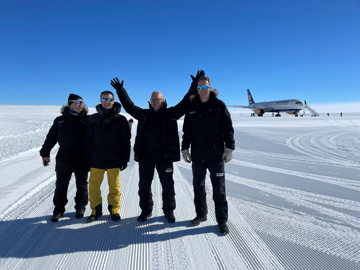The four person crew has in one month already finished a ropeway (header photo) between the mountains Nonshøgda nord and Nonshøgda Sør. The ropeway will be used mainly to ship material to extend an existing building containing technical infrastructure for one of the many services KSAT provides from Troll.
The crew has also pulled a new power cord up to Nonshøgda Nord – bigger than your usual one – it’s as long as 800 meter and weighs around 1500kg. That is a pretty heavy accomplishment.

Manual work
A brand new road is also being built at the station. The road is needed in order to build and access the six new antennas that is planned for this summer season.
The manual load is heavy on the team. The terrain is uneven and there are many meters of height to climb up and down to get to the places where the foundations of the new infrastructure and antennas are being put into place. The weather is also playing a significant – and unpredictable - role.
– It’s been challenging, especially because the team has had their share of bad weather, system engineer Thomas Rochmann says, and adds:
– Despite the weather we are on schedule and the crew has done a tremendous job.
For Christmas, there will be traditional food available, as well as Christmas decorations and maybe a present or two as well.

Double hurricanes
So far there has been several storms with wind speeds twice as fast as hurricane speeds (32.6 m/s) at Troll. There are days when the crew can do nothing but stay indoors and wait until the wind has laid down. Those days the tasks are to prepare for the technical installations inside, removing old legacy equipment and doing inventory checks.
In addition, the crew has to spend one day to secure everything from containers, vehicles and tools. The strong wind combined with sand, snow and flying debris makes it too dangerous to work outside.
In fact, the challenging weather conditions is the reason for the monthly flight to Troll being delayed. The plane could not take off from Oslo before the wind has laid down, and the most important issue: the airstrip cleared. And that takes a couple of days as well once the wind has calmed down.
– When the snow and wind set in, the airstrip is obviously filled with snow. With the equipment the Polar Institute have at their disposal and the size of the airstrip needed, it takes a couple of days to clear. The plane can’t take off from Oslo before there is no doubt surrounding the landing conditions at Troll, Rochmann points out, himself traveling to Troll January 25th, when the next flight is due.

In the Company of birds
The plane flies non-stop for 13 hours to Cape Town, filled with crew from both KSAT and the Norwegian Polar Institute, also present at Troll. There are carpenters, scientists and engineers onboard. After refuelling, the plane flies for another 5 hours to Antarctica, but with no option to return once a certain point above the sea is crossed.
On the other pole – the opposite side of the world, it’s equally cold and windy. But unlike Svalbard, where KSAT has the other ground station for polar latitudes, the crew at Troll may hike without a weapon, being anxious for the next polar beer to turn up.
Because at Troll Station, the only living creatures except the 30-ish people present, are birds.



